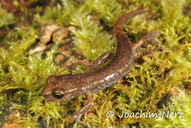|
Description
Total length to 116 mm for males (average 96.28 mm), 123 mm for females (average 100.34 mm). Head oval when viewed from above and about 1/8 of the total length. Snout rounded and with a slight overbite, especially in males. Adult males have a mental gland on the chin. Tail oval in cross section and slightly less than half the total length. Trunk square in cross section, with 13 costal grooves. Limbs well developed, hind legs slightly longer than front legs. Front feet with 4, hind feet with 5 flattened digits. Coloration as in other Hydromantes species highly variable. Base color from light brown to black. A dark V, inverted V or X may be present in the neck. Markings consist forther of spotted, blotched, striped or reticulated pattern. Pattern may be in red, yellow, gray or green and these colors can occur on the same animal, often with a metallic sheen (Boehme et al 1999). Distribution and Habitat
Country distribution from AmphibiaWeb's database: Italy. Introduced: Spain.
H. ambrosii is endemic to SE French and NW Italian, ranging from the Alpes-de-Haute-Provence to NW Tuscany through the Maritime Alps, Ligurian Alps and Ligurian Apennines (Provinces of Imperia, Cuneo, Savona, Genova, Alessandria, Pavia, Piacenza, perhaps Parma; La Spezia, Massa Carrara). Actually the true H. ambrosii inhabits only the provinces of La Spezia and Massa-Carrara, their northwesternmost parts excluded, where H. strinatii occurs.H. ambrosii occurs in the western part of its range from almost sea level to 2290 m or even 2432 m in the Maritime Alps (now H. strinatii), and in the eastern part it is found up to 1730 m in the Apuan Alps. H. ambrosii is common in most of its range, mainly because it is not dependent on water for reproduction and can escape extreme surface aridity and/or temperatures by penetrating underground cavities to varying depths (caves, crevices, etc.) were it can usually continue an active life. Moreover, contrary to widespread opinion, it also occurs on non-calcareous substrata and in regions devoid of any caverns. Like congeners, it is basically a nocturnal and rupicole species which can be found in various habitats, from forest to semi barren rocky sites; on the surface and within the caves, it usually occurs with relative humidity of 75-100% and air temperature of 3-18ºC. (Gasc 1997). Life History, Abundance, Activity, and Special Behaviors
There is little data available on the reproduction of H. ambrosii in its natural habitat. Sperm transfer takes place through cloacal contact. Most gravid females are found in the fall (Salvidio 1993). Observations in captivity show that H. ambrosii (actually H. strinatii) hides its ivory white eggs among loose rocks and leaf litter. A clutch contains 6-14 eggs of 5-6 mm in diameter. The females seem to keep in contact with their eggs. The eggs undergo direct development. After 5 months, the egg starts to swell due to increased water uptake. After 8 months, the egg has reached a diameter of 10mm. The egg then contracts until hatching after 10 months (all at 12ºC). The young are 22-24 mm in length upon hatching. Development to sexual maturity takes 3 to 4 years. Direct observation in captivity has shown that this species may live up to six years. Recapture of a single individual, however, may provide evidence for a life span of over 17 years. H. ambrosii seems to be an opportunistic hunter with a wide range of invertebrate prey (Boehme et al 1999). Trends and Threats
The Mediterranean region is subject to increasing human habitation causing pollution, deforestation, fires, loss of surface waters and introduction of exotic species. Despite these factors, H. ambrosii is not endangered. This is mainly due to its relatively large distribution and its water-independent biology (Boehme et al 1999). H. ambrosii is abundant in its range and should not be considered an endangered species (Gasc 1997). Any conservation measures taken to protect H. ambrosii should focus on the conservation of suitable habitats, like forests and cave systems (Noellert and Noellert 1992). Possible reasons for amphibian decline General habitat alteration and loss
Habitat modification from deforestation, or logging related activities
Subtle changes to necessary specialized habitat
Comments
H. ambrosii has recently been subject to reevaluation (Nascetti et al 1996). The validity of the hitherto recognised 5 subspecies is questionable in light of these recent genetic studies (Boehme et al 1999).
References
Boehme, W., Grossenbacher, K., and Thiesmeier, B. (1999). Handbuch der Reptilien und Amphibien Europas, band 4/I:Schwanzlurche (Urodela). Aula-Verlag, Wiesbaden.
Duellman, W. E., and Trueb, L. (1986). Biology of Amphibians. McGraw-Hill, New York.
Gasc, J.-P. (1997). Atlas of Amphibians and Reptiles in Europe. Societas Europaea Herpetologica, Bonn, Germany.
Nascetti, G., Cimmaruta, R., Lanza, B., and Bullini, L. (1996). ''Molecular taxonomy of the European plethodontid salamanders (genus Hydromantes).'' Journal of Herpetology, 30(2), 161-183.
Nöllert, A. and Nöllert, C. (1992). Die Amphibien Europas. Franckh-Kosmos Verlags-GmbH and Company, Stuttgart.
Salvidio, S. (1993). ''Life history of the European plethodontid salamander Speleomantes ambrosii (Amphibia, Caudata).'' Herpetological Journal, 3, 55-59.
Originally submitted by: Arie van der Meijden (first posted 1999-10-20)
Edited by: David B. Wake (Jan., 2000) (2002-05-25)Species Account Citation: AmphibiaWeb 2002 Hydromantes ambrosii: Ambrosi Salamander <https://amphibiaweb.org/species/4071> University of California, Berkeley, CA, USA. Accessed Apr 22, 2025.
Feedback or comments about this page.
Citation: AmphibiaWeb. 2025. <https://amphibiaweb.org> University of California, Berkeley, CA, USA. Accessed 22 Apr 2025.
AmphibiaWeb's policy on data use.
|




 Raffaëlli Account
Raffaëlli Account Map of Life
Map of Life